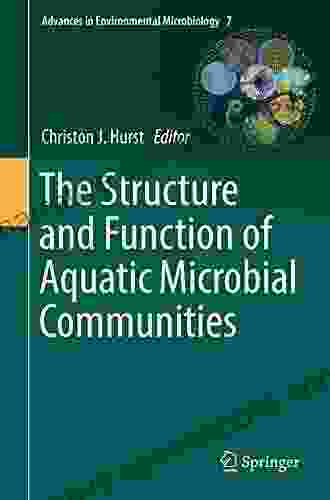Delve into the Microscopic Realm: The Structure and Function of Aquatic Microbial Communities

4.2 out of 5
| Language | : | English |
| File size | : | 32030 KB |
| Text-to-Speech | : | Enabled |
| Screen Reader | : | Supported |
| Enhanced typesetting | : | Enabled |
| Print length | : | 633 pages |
Beneath the surface of our oceans, lakes, and rivers lies a vibrant and complex world of microscopic organisms known as aquatic microbial communities. These communities play a fundamental role in the functioning of aquatic ecosystems, shaping the food web, nutrient cycling, and biogeochemical processes that sustain life in these vast expanses of water.
Structure of Aquatic Microbial Communities
Aquatic microbial communities are incredibly diverse and can vary greatly in composition and structure depending on environmental factors such as temperature, salinity, pH, and nutrient availability. The most common types of microorganisms found in aquatic environments include:
- Phytoplankton: Microscopic algae that perform photosynthesis and form the base of the aquatic food web.
- Zooplankton: Small animals that feed on phytoplankton and other microorganisms.
- Bacteria: Single-celled organisms that play a crucial role in nutrient cycling and decomposition.
- Archaea: Single-celled organisms similar to bacteria but with distinct cellular structures.
Function of Aquatic Microbial Communities
Aquatic microbial communities perform a wide range of essential functions that are vital for the health and productivity of aquatic ecosystems. These functions include:
- Primary production: Phytoplankton use sunlight to convert carbon dioxide into organic matter, providing the foundation for the aquatic food web.
- Nutrient cycling: Bacteria and archaea play a key role in breaking down organic matter and recycling nutrients such as nitrogen and phosphorus.
- Biogeochemical processes: Microorganisms are involved in a variety of biogeochemical cycles, including the carbon cycle, nitrogen cycle, and sulfur cycle.
- Food web dynamics: Zooplankton and other microorganisms serve as food for larger aquatic organisms, including fish, birds, and marine mammals.
Advancements in Microbial Ecology
In recent years, advancements in molecular techniques and sequencing technologies have revolutionized the field of microbial ecology. These advancements have allowed researchers to gain unprecedented insights into the structure, function, and diversity of aquatic microbial communities.
One of the most significant developments in microbial ecology has been the ability to sequence and analyze the entire genome of microorganisms. This technique, known as metagenomics, has provided a wealth of information about the genes and metabolic pathways that are present in aquatic microbial communities.
Another important advancement has been the development of high-throughput sequencing technologies, which have made it possible to sequence large numbers of microbial samples in a relatively short period of time. This technology has allowed researchers to study the diversity and dynamics of aquatic microbial communities in unprecedented detail.
The structure and function of aquatic microbial communities are essential for the health and productivity of our oceans, lakes, and rivers. Through advancements in microbial ecology, we are gaining a deeper understanding of the complex interactions between microorganisms and their environment. This knowledge is crucial for managing and conserving aquatic ecosystems and for addressing the challenges of climate change and pollution.
References
- Azam, F., & Malfatti, F. (2007). Microbial structuring of marine ecosystems. Nature Reviews Microbiology, 5(10),782-791.
- Falkowski, P. G., & Raven, J. A. (2013). Aquatic photosynthesis. Princeton University Press.
- Ghobrial, S., & Wüest, A. (2015). The dynamic interplay between aquatic microbial communities and biogeochemical processes in lake systems. Annual Review of Ecology, Evolution, and Systematics, 46(1),47-67.
4.2 out of 5
| Language | : | English |
| File size | : | 32030 KB |
| Text-to-Speech | : | Enabled |
| Screen Reader | : | Supported |
| Enhanced typesetting | : | Enabled |
| Print length | : | 633 pages |
Do you want to contribute by writing guest posts on this blog?
Please contact us and send us a resume of previous articles that you have written.
 Book
Book Novel
Novel Page
Page Chapter
Chapter Text
Text Story
Story Genre
Genre Reader
Reader Library
Library Paperback
Paperback E-book
E-book Magazine
Magazine Newspaper
Newspaper Paragraph
Paragraph Sentence
Sentence Bookmark
Bookmark Shelf
Shelf Glossary
Glossary Bibliography
Bibliography Foreword
Foreword Preface
Preface Synopsis
Synopsis Annotation
Annotation Footnote
Footnote Manuscript
Manuscript Scroll
Scroll Codex
Codex Tome
Tome Bestseller
Bestseller Classics
Classics Library card
Library card Narrative
Narrative Biography
Biography Autobiography
Autobiography Memoir
Memoir Reference
Reference Encyclopedia
Encyclopedia Allyson P Brantley
Allyson P Brantley John Stainer
John Stainer James Bender
James Bender Kate Taylor
Kate Taylor Aloysius Yongbi Fontama
Aloysius Yongbi Fontama Anthony Haywood
Anthony Haywood Emily Henry
Emily Henry Alobeda S
Alobeda S Marty Becker
Marty Becker Andrew Bernard
Andrew Bernard Aliyah Burke
Aliyah Burke Penny Parsons
Penny Parsons Svetlana Ilizarov
Svetlana Ilizarov Robert D Romanyshyn
Robert D Romanyshyn Jeffrey B Graham
Jeffrey B Graham Leonardo E Arteaga Ibarra
Leonardo E Arteaga Ibarra Almondie Shampine
Almondie Shampine Dan Amerson
Dan Amerson Bobby Miller
Bobby Miller Tracy Rees
Tracy Rees
Light bulbAdvertise smarter! Our strategic ad space ensures maximum exposure. Reserve your spot today!

 Tyler NelsonDiscover the Enchanting Heart of Spain: An Intimate Journey Through History,...
Tyler NelsonDiscover the Enchanting Heart of Spain: An Intimate Journey Through History,...
 Samuel WardEmbark on a Crochet Adventure with Apache Rose Afghan Blanket: A Masterpiece...
Samuel WardEmbark on a Crochet Adventure with Apache Rose Afghan Blanket: A Masterpiece... Martin CoxFollow ·7.2k
Martin CoxFollow ·7.2k Billy PetersonFollow ·10.5k
Billy PetersonFollow ·10.5k Albert ReedFollow ·13.4k
Albert ReedFollow ·13.4k Yasunari KawabataFollow ·18.9k
Yasunari KawabataFollow ·18.9k Morris CarterFollow ·9.3k
Morris CarterFollow ·9.3k Ervin BellFollow ·9.3k
Ervin BellFollow ·9.3k Terry PratchettFollow ·15.6k
Terry PratchettFollow ·15.6k Aubrey BlairFollow ·16k
Aubrey BlairFollow ·16k

 F. Scott Fitzgerald
F. Scott FitzgeraldUnravel the Enigmatic Murder of Mary Russell: A...
Prologue: A Grisly Discovery In the...

 Connor Mitchell
Connor MitchellLittle Quilts: Gifts from Jelly Roll Scraps
Embrace the Art...

 Harold Powell
Harold PowellPoverty Survival Hope In An American City: A Pulitzer...
A testament to the resilience of the human...

 Ray Blair
Ray BlairConfronting Global Warming: Population, Resources, and...
Global warming is one of the most pressing...

 Gary Cox
Gary CoxStyle Your Most Authentic Self and Cultivate a Mindful...
Unlock Your True...

 Caleb Long
Caleb LongEmbark on a Colorful Patchwork Adventure: Discover 20 To...
Step into the captivating world of...
4.2 out of 5
| Language | : | English |
| File size | : | 32030 KB |
| Text-to-Speech | : | Enabled |
| Screen Reader | : | Supported |
| Enhanced typesetting | : | Enabled |
| Print length | : | 633 pages |








